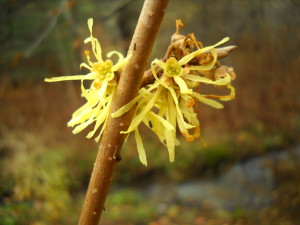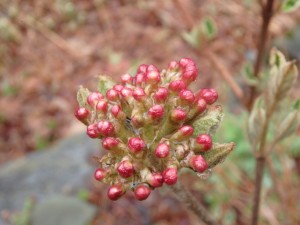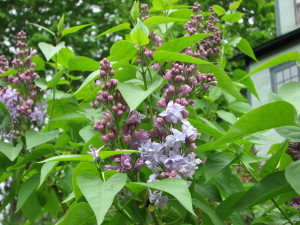Shrubs with Fragrant Flowers
Some gardeners grow flowers for their beauty in the garden. Others for their magnificence in a vase. A few select species largely for their scent. My friend Nelia Sargent of Claremont is in this third category, largely because she is blind. I called her recently to see what flowering shrubs she likes best.
Nelia loves shrubs because they pack so many flowers in a small space. And, unlike most perennial flowers, they have their blossoms close to nose level. Who needs to bend over to sniff a peony if you have old fashioned shrub roses standing up 3 or 4 feet tall? Here are some of her favorites along with a few of mine –roughly in sequence of their blossoms.
First for her, in late March or early April, is a witchhazel hybrid (Hamamelis x intermedia) called ‘Arnold’s Promise’. This flowers heavily with yellow strap-like petals an inch long originating at a reddish calyx cup. Although this bush can get large – up to 20 feet tall and wide, I have never seen one half that size, here in the North Country. I have our native witchhazel which blooms in late fall, but this hybrid is a great plant and one I should get. It’s very fragrant.
At the same time (or soon thereafter) is February Daphne, a tidy pink shrub that is very highly fragrant. I love this one so much I named my corgi after it. I’ve had mine for a dozen years and never had to prune it, which is a plus. I’ve seen it growing wild by the side of the road, which makes me wonder if it will be invasive sometime in the next 50 years. But since I’ve not gotten one seedling and it grows slowly, I’m not too worried.
Nelia Sargent then listed a number of viburnums that are fragrant and lovely. Three that she mentioned are Viburnum juddii, V. carlessii, and V. burkwoodii. Don’t be put off by the Latin names. Just pronounce the species names like juddii with an E-I sound at the end. All three species were named after horticulturists.
Viburnum juddii gets to be 6 to 8 feet tall tall, with blossoms about 3 inches across. V. carlessii, also called Koreanspice viburnum, gets to be 4 to 5 feet tall and wide, with 2 to 3 inch semi-snowball flowers. The Burkwood viburnum can get 8 to 10 feet tall with spread about 2/3’s its height; like the others, its flowers are pink in bud, opening to white and highly fragrant.
In recent years there has been an invasive beetle that has terrorized many viburnum owners. Cornell University has listed viburnums according to their susceptibility. Burkwood viburnum was listed as moderately susceptible to defoliation, but V. carlessiiand V. juddii were in the group least attractive to the beetle. You can see the entire list at http://www.hort.cornell.edu/
After the viburnums bloom, and overlapping with them, are the lilacs. Nelia Sargent noted that there are early, mid-season and late lilacs, so one can have fragrant lilacs for at least 5 weeks. First for her comes one called Sister Justina, a white one that stays tidy and does not send up root suckers. ‘Gertrude Lesley’, a double white is also early and nicely fragrant. The common lilac,Syringa vulgaris, has 800 or 900 named varieties. Most are mid-season and nicely fragrant. These spread by root, sending up suckers that will create a hedge if you are not attentive.
Fragrant late season lilacs include Miss Kim (a cultivar of Syringa patula), a slow-growing variety that is (mistakenly) sometimes called a miniature. Mine is now over 8 feet tall, definitely not a dwarf! Another late beauty is ‘Donald Wyman’ (Syringa x prestoniae ‘Donald Wyman’) which is hardy to Zone 2 (minus 50 Fahrenheit) and will thrive despite pollution and compaction in wet or dry soils! One tough plant.
The final shrub on Nelia’s list is mockorange (Philadelphus coronarius). Not related to oranges, this 10 to 12 foot shrub has white blossoms that are sweetly fragrant. That said, be advised that not all cultivars are fragrant, so buy one in bloom. It is an old fashioned flower and not particular to soil type.
Roses can be lovely and fragrant, but many of the modern hybrids have little or no scent. The Knockout roses are fabulous disease-resistant roses that bloom most of the summer, but I’ve only encountered one that was fragrant. On the other hand, rugosa roses are highly fragrant, as are many of the old fashioned roses. I recommend buying them when in bloom if fragrance is important.
I agree with Nelia Sargent: shrubs with fragrant blossoms are a good addition to the landscape. And they are often great for our native pollinators, too.
Read Henry’s garden blog at https://dailyuv.com/





